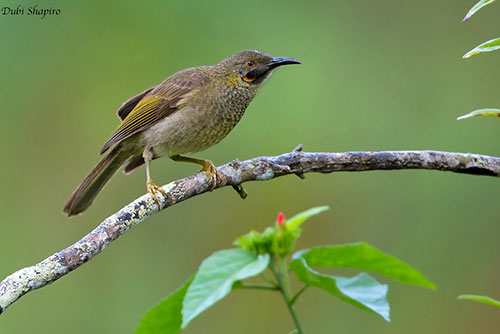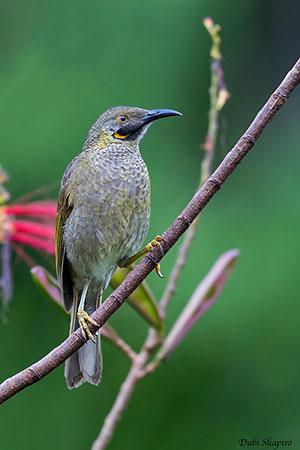
During the breeding season, the Kikau can be seen alone or in pairs, or in small groups of 3-4 individuals. But outside this period, the birds form noisy flocks from 8-10 individuals to several dozens, gathering around flowering vegetation.
They are often aggressive and chases and fights with both conspecifics and other species, are frequently seen.
The Kikau is territorial during the breeding season. Disputes often occur between owner and intruders.
The Kikau may perform some movements to SW Fiji, with observations from Kadavu.
When the bird is foraging, the flight is agile with fluttering and flitting action between trees and shrubs.
REPRODUCTION OF THIS SPECIES:
The Kikau probably breeds all year-round, and at least two broods are raised, but possibly more.
The cup-shaped nest is a loose structure made with coiled rootlets. It is suspended from a horizontal fork by the rim. It is placed in tree or shrub between 1 and 2,50 metres above the ground.
The female lays 2-3 pale eggs with dark markings. The chicks are fed by both parents, but they depend on adults for long time.
PROTECTION / THREATS / STATUS:
The Kikau has restricted range, but it is relatively common and even abundant in very suitable habitat.
The size and the trend of the population are unknown, but the species is not globally threatened.
The Kikau is currently evaluated as Least Concern.
Fr: Méliphage d'Ovalau
Ang: Kikau
All: Westfidschi-Honigfresser
Esp: Mielero carunculado de Viti Levu
Nd: Kikauhoningeter
Sd: sydlig flikhonungsfågel
Photographer:
Dubi Shapiro
Dubi Shapiro Photo Galleries & Dubi Shapiro's Pictures on IBC
Text by Nicole Bouglouan
Sources:
HANDBOOK OF THE BIRDS OF THE WORLD Vol 13 by Josep del Hoyo-Andrew Elliot-Jordi Sargatal - Lynx Edicions – ISBN: 9788496553453
Birds of Southwest Pacific: A Field Guide to the Birds of the Area between Samoar New Caledonia, and Micronesia By Ernst Mayr, Mayr – Editeur: Tuttle Publishing, 2012 – ISBN: 146290890X, 9781462908905 - 347 pages
Wikipedia, the free encyclopaedia
Fatbirder - linking birders worldwide... Meliphagidae
CREAGUS – Don Roberson - HONEYEATERS Meliphagidae
Home page
Page Passeriforme Order
Kikau
Foulehaio procerior
Passeriformes Order – Meliphagidae Family
INTRODUCTION:
The Kikau is endemic to Fiji. It was until recently a subspecies of F. carunculatus. It is now a full species which differs by its darker plumage overall.
It frequents a variety of wooded habitats and typically feeds on insects and nectar from flowers.
The species is relatively common but it has restricted range. It is not globally threatened.
DESCRIPTION OF THE BIRD:
Biometrics:
Length: 19-21 cm
Weight: 25-45 g
The Kikau has fairly dark olive upperparts with heavy blackish-olive mottled and scaled pattern. Upperwings and tail are dark olive-brown to dark brown. Flight-feathers and wing-coverts show yellow-olive edges.
The underparts are strongly mottled or scaled, and especially on the breast. Lower belly and vent are mostly whitish.
The head is like the upperparts, except for the bare yellow skin forming a narrow, bare, submoustachial stripe, bordered above and below by black feathers. The ear-coverts are greyish-olive, with small, more yellowish area at rear.
The long, down-curved bill is black. The eyes are dark brown with yellow-orange orbital ring. Legs are greyish whereas feet are yellow.

Male and female have similar plumage, but the female is slightly smaller than male.
The juvenile resembles adult, but it is darker and duller. The wattle is smaller. The upperparts are brownish with faint olive tinge, whereas the underparts are paler. Chin, throat and breast are more heavily mottled.
RANGE:
The Kikau is found on several islands in W and C Fiji, such as Yasawa and Mamanuca Groups, Viti Levu, Vatulele, Beqa, Lomaiviti Group, (including Ovalau) and Yasayasa Moala Group.
HABITAT:
The Kikau frequents a variety of forested areas including moist lowland forest, mangroves and moist montane forests.
On Viti Levu, it can be seen from sea-level to 1,450 metres of elevation.
CALLS AND SONGS: SOUNDS BY XENO-CANTO
The Kikau’s common call is a ringing “kee-kow” often repeated. This call gives the bird its name “Kikau”.
The melodious song is described as “ti-ti-tui-tui-tui-twee” or a whistling gurgling “churwee-churwee-churdle-twee-twur”.
It gives loud bubbling calls in alarm in response to predators and these calls may vary depending on type and size of the predators.
Duetting occurs, with both birds perched one metre apart on the same branch.
BEHAVIOUR IN THE WILD:
The Kikau feeds primarily on insects and nectar, the latter from a variety of flowering plants including trees, shrubs and palms. It probably feeds on fruit and berries too, and gleans arthropods on foliage or sallies to catch them in flight. It may come to the ground but it forages mainly high in trees.
It is very active while foraging, fluttering almost continuously between flowering trees and plants. It also hangs from twigs to reach and probe flowers.
